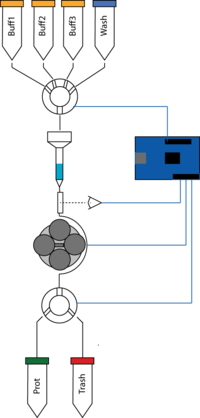APPS
Objective and context
In laboratory, routine tagged-protein (His or strep tagged proteins) purification is usually made manually with the the help of resins. This procedure is often, so to say, boring and repetitive. Automatic alternatives exist but are costly (8000 - 15000), bulky and often too specific for such simple but long task. The idea is to develop a small, (semi-)automatic, cheap(er) and modulable protein purification system for most of the routine task.
Routine Protein Purification
In the world of protein engineering, enzymology, drug development and synthetic biology, amounts of pure proteins are required to study and evaluate the potential of an enzyme to be a candidate for future development. One routine example of protein production and purification would be the following: A bacterial strain is transfected with a plasmid containing the protein of interest (POI) tagged at its C and N termini with His and Strep tags. The POI would be expressed by the strain (i.e. e.coli) in liquid culture. The bacteria in the cultures would by lysed and the homogenate purified. A usual purification would involve to prepare a column and pack it with a resin such as the His purification resin. The column would be (i) equilibrated with a first buffer, (ii) the homogenate would be slowly passed through the column, (iii) a second buffer would be flown through the column to remove all the remaining unwanted bacterial debris. All these step are made with the help of a peristaltic pump to apply suction but the performer has to stay by the system to ensure that the resin never becomes dry. (iv) A last buffer would be used to unblock the protein from the resin and collect it in a gravity dependent manner. These purification steps will be then performed again with a second type of resin to ensure total purity of the protein.
This procedure occupies a large amount of the time of a scientist and could be in this way automatized.
System design
Schematically the system would be composed of several modules: A buffer holder where several 50ml tubes can be stored, a column holder where various sets of columns could be fitted, a 280 LED based optical cell, a peristaltic pump, a simple trash/sample collection system and a controller (Arduino or Raspberry Pi) + display.
UV system
The UV system will be composed of 280nm emitting LED and a UV detector. The optical chamber will be made as a 1cm U shaped pathway (described below)
280 nm LED
Several European and American LED providers exist but propose prices that are way above reasonable price for such LEDs.
The following LED providers were investigated. (accessed 08.2015)
| Provider | prices | links | Comment |
|---|---|---|---|
| Roithner lasers | Expensive | link1, link2 | |
| Intl UV LEDs | Around 34.5 $ / LED | link | |
| ThorLab | Expensive | link | |
| Seoulviosys | Expensive | link | |
| Qphotonics | Expensive | link | |
| TME | Around 20/LED (can buy single ones) | link | three units were ordered here Datasheet |
| Alibaba | - - - | link | Company verified, 6yr business, Iso compliant. |
| Taobao | 1.20.- per LED | link | 280nm , 0.5 - 30. mW |
| Ledwv | - - - | link |
UV detectors
We will use for starters UV detectors compatible for arduino to facilitate the development. These are often cheap and can be bought for testing.
| Provider | name | price | links | Comment |
|---|---|---|---|---|
| Adafruit | GUVA-S12SD | 6.50$ | link Datasheet | 22% of maximal theoretical absorbance at 280nm |
| Adafruit | Broad spectrum SI1145 Digital UV Index / IR / Visible Light Sensor | 9.95$ | Datasheet link |
UV Transparent material
We need UV transparent material for the flow cell. We will first try to cut small portion of those 1cm UV spectrometers optical cells.
Quartz pieces could be used as well.
Hydraulics
Since the flow system is based on a peristaltic pump, low pressure tubing could be used. We will base the system on what is the most standard luers and connectors to optain an easily plugable watertight system.
Luers and connectors
Several large scale providers were investigated and often large batches match in these companies match the prices of single units in specialized companies (seriously Bi**ad... )
| Provider | price | links | Comment |
|---|---|---|---|
| Cole-Parmer | 10-15 $ for 25x transparent luers units, 10$ for manifolds | link | |
| Nordson | - - - | link | Large batch orders of luers, fittings and tubes. |
Columns
We will base our system on standard polypropylene columns but will expand to larger varieties of columns afterwards. Several providers were investigated.
| Provider | price | links | Comment |
|---|---|---|---|
| Quiagen | 193 per 50 units | link | 1ml resin / 6 ml total |
| Quiagen | 250 per 50 units | link | 5ml resin / 15 ml total |
A decent alternative for closing the column top would be the following product (95$ / unit, big nope but you get the idea) For the purification of 1 to 5 mg of protein 1ml resin is usually enough.
Pumps
The system should be operating under low pressure and usually tubings should be in silicon. The pumping unit will be a peristaltic pump. Several providers were investigated.
| Provider | price | links | Comment |
|---|---|---|---|
| Adafruit | 25$/u | link | likely compatible with arduino (example) |
| Sparkfun | 120$/u | link | pretty expensive... |
| Welco | ~70euros | link | Several compact types of pumps |
| Elecrow | 4$/u | link | cheap, 9v, 1.2m suction. |
